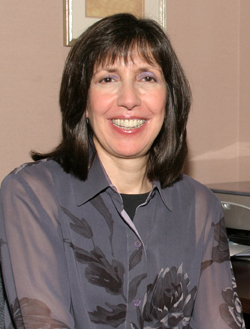
A baby fascinated with spinning a cup, a toddler flapping his hands, or a preschooler walking on her toes: Parents and even doctors sometimes miss these red flags for autism, but a new online video "glossary" created by a team including FSU Professor Amy Wetherby makes them startlingly clear.
Wetherby, the L.L. Schendel Professor of Communication Disorders, a nationally known autism researcher, has collaborated with two non-profit autism organizations to launch a first-of-its-kind Web-based video glossary to help parents and professionals learn more about the early warning signs of autism spectrum disorders (ASD).
Autism Speaks, a non-profit organization dedicated to increasing awareness of autism and raising money to fund autism research, together with First Signs, the leader in early identification and intervention of children with developmental delays and disorders, and Wetherby’s FIRST WORDS Project announced the launch of the video glossary on Monday. In an indication of the significant need for the unique resource, media around the world immediately reported on its availability and its value to parents and medical professionals.
The glossary is free and available to the public at firstwords.fsu.edu, www.autismspeaks.org, and www.firstsigns.org. It contains more than a hundred video clips that illustrate both typical and atypical development of young children. The goal of the project is to help parents of children suspected of or recently diagnosed with autism better understand some of the words and terms they might hear used in association with ASD. Video clips are used to show examples of such technical terms as social reciprocity, joint attention, sensory defensiveness, hand flapping and echolalia.
Wetherby, director of the FIRST WORDS Project, oversaw the selection of appropriate and descriptive video clips. The FIRST WORDS Project is an ASD early identification and intervention program.
"We have carefully chosen clips that can help parents see for themselves what typical behavior looks like, as well as behavior that might raise a red flag," she said. "These clips also help demystify terms that can sound complex but represent important behavioral clues. These clues or early red flags of autism may indicate that there should be concern about a child’s development."
In many cases, side-by-side video clips show behaviors that are typical in contrast with those that are red flags for ASD. Video clips that give parents short windows into the different types of therapies will be added to the site next year. The glossary will also be a useful resource to healthcare providers and other professionals who may not have experience in diagnosing young children with ASD.
The American Academy of Pediatrics (AAP) will feature the ASD video glossary in its soon-to-be released Autism Toolkit. The glossary offers two entry points—the first is organized around the diagnostic features of ASD and the second is an alphabetical list of terms associated with ASD. Both entry points lead to video clips that illustrate the terms. "If pictures are worth a thousand words, then these videos are worth a million," said Suzanne Wright, co-founder of Autism Speaks. "Our hope is that this new tool will help parents better understand behaviors they see in their children and learn more about terms that have been used by doctors or educators so that parents can be the best possible advocates for their children."
"The goal of this initiative is to facilitate earlier diagnosis and intervention for children with autism," said Nancy D. Wiseman, founder and president of First Signs. "Right now, early intervention is the best weapon we have against autism. We want parents to be able to recognize those early warning signs and communicate their concerns more effectively with their pediatrician."
WhiteBlox is Autism Speaks’ technology partner on the autism video glossary project, providing a custom-tailored interactive media software system to power the glossary and enable its most robust features, including the side-by-side video players.
Autism is an umbrella term for a wide spectrum of disorders referred to as Pervasive Developmental Disorders (PDD) or Autism Spectrum Disorders (ASD). They are a group of neurobiological disorders that affect a child’s ability to interact, communicate, relate, play, imagine and learn and are often accompanied by extreme behavioral challenges.
Autism Spectrum Disorders are diagnosed in one in 150 children in the United States, affecting four times as many boys as girls. The diagnosis of autism has increased tenfold in the last decade. The Centers for Disease Control and Prevention (CDC) have called autism a national public health crisis whose cause and cure remain unknown.
Wetherby recently was awarded a four-year grant expected to total nearly $1.4 million from the CDC to determine the prevalence of ASD in children under age 4. The new study will expand Wetherby’s FIRST WORDS Project by screening 16,000 children in North Florida.
FSU’s FIRST WORDS Project is a prospective, longitudinal research investigation designed to identify early red flags of autism spectrum disorders from videotapes of children screened under 24 months old who are later diagnosed with autism. Besides the CDC, Wetherby has received funding from the U.S. Department of Education and the National Institutes of Health. The research findings will have important implications for improving early screening and evaluation tools.



